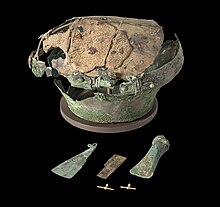Lusehøj
Originally about 36.0 m in diameter and about 8.0 m high, Lusehøj is a tumulus ( Danish oldtidshøj ) from the late Bronze Age (about 800 BC). It is located not far from Buskehøj , southwest of Voldtofte on the Danish island of Funen . The name is based on the Danish word " Lys ", for light.
Lusehøj was excavated in 1861 on behalf of King Frederik VII , who was interested in archeology . The excavation was unskilled and incomplete. A new investigation was therefore carried out from 1973 to 1975. Lusehøj has been confirmed as the final resting place of a wealthy chief. Grave goods included an imported drinking vessel, two bronze cups , an oath ring , buttons made of gold , an iron ring, a sword and parts of a carriage. In the bronze urn, which probably comes from the southeastern Alpine region, the burned bones of a man lay wrapped in a cloth.
Textile investigation
The production of woven textiles from plant fibers has long been closely linked to the development of agriculture and the cultivation of flax or hemp . An examination of the 2800 year old textiles from the Bronze Age Lusehøj calls this into question. The textile is made of fiber islands , which (like the urn) probably come from the Carinthia - Styria region. This indicates that textile production in the Bronze Age in Europe was not entirely based on cultivated plants, but continued to be based on the use of wild plants. The investigation of Lusehøj textiles points to the role of nettle as a raw material, which was not recognized during the Bronze Age, and shows the need for a reassessment of textile production in prehistoric Europe.
See also
literature
- Ingrid Falktoft Anderson: Vejviser til Danmarks oldtid . 1994, ISBN 87-89531-10-8 , pp. 216-217, 257
- C. Bergfjord et al .: Nettle as a distinct Bronze Age textile plant. In: Scientific Reports 2, 2012.
Web links
- Lusehøj , entry at Fund og Fortidsminder , Kulturarvsstyrelsen (Danish)
- Description Danish and pictures
Coordinates: 55 ° 14 ′ 38.2 " N , 10 ° 2 ′ 38.5" E
